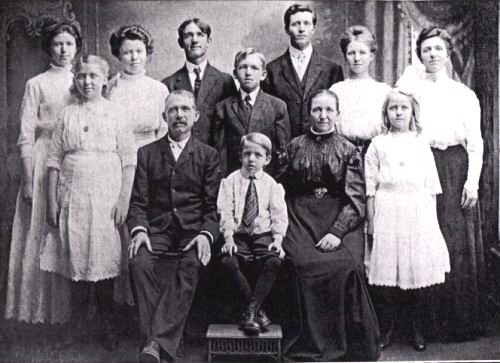The Harm Uden Cremer Family
"My Family's Relation"
"Genealogy of Course"
This page is, and will be, under constructionfor as long as these familiescontinue to grow. Check back often!
"The Harm Uden Cremer Family"

Bottom row, from left to right
Elisabeth... GrandPa... Folkert... GrandMa... Greta
Top row, Left to right
Anna... Ida... Frederich... Herman... Udo... Minnie... Helen
Harm Uden Cremer was born in Dornumergrode, Ost-Friesland, Germany on November 5, 1857. His father, Ude Hinrichs Cremer was a shoemaker.
Miss Ida Deborah Phlüger was born in Dornem, Ost-Friesland, Germany on February 16, 1864. Her father was also a shoemaker. Ida had 5 brothers and sisters. Folkert Frerichs, Anna Elisabeth, Tomke Elisabeth, Weert Harms Frerichs, And Frerich Weerts.
Harm Uden and Ida Deborah were married on October 5, 1884. By 1889, before coming to America, they had four children. One son, Udo Herman, was born June 1, 1887 and died March 29, 1888. The next Udo Herman was born Septenmber 22, 1888 and before he was 6 months old, the family was in America.
Ida's sister, Tomke Elisabeth, married Heinrich Frerichs Biermann. They had 5 children in Germany before they came to America and settled in Benson, Illinois. Frerich Janshen, Johann Hinrichs, Hilke Hinrichs. Class Hinrichs was born January 13, 1883 and died January 26, 1883.The next son, Class Hinrichs, was named after the son that died, and Folkert Hinrichs.
In early 1889, Harm and Ida followed them and settled near Benson also. For several years, Harm did odd jobs around the area. The family then moved to Minonk, Illinois, and Harm got the job of firing the bricks at the brick factory in town.
After four years, Harm quit the brick factory and started laying tile for farmers to drain their fields. He had enough work lined up that at times he had 5 men helping him. It is said that one tile line was a mile long, and at one place was 11 feet deep to go through some high ground.
Four years later, Harm got his first farm to rent. It was just west of Minonk. Then he got a larger farm south and east of Toluca, owned by a Mr. Stoddard. He did a good job farming, renting this farm for nine years, and he then rented the Stoddard farm west of Minonk, 400 acres in all. There was 200 acres of corn every year, and 200 acres of oats, hay and pasture land. This was in the era of 1900. I can not imagine starting to cut and shock 100 acres of oats. Then the time to thrash it. And in the fall, starting to harvest 200 acres of corn, by hand! The whole family worked at harvest time. Harm had one wagon, Udo one, Jim Sunken, a hired hand had one, Herman had one, and then two of Harms girls had one wagon.
Harm had the first corn elevator in the area to put the corn in the crib. No more scooping it in. There was a wagon jack to lift the front of the wagon to better get the corn out. The "dump" was powered by a team of horses.
In 1904, the "Worlds Fair" came to St. Louis, Missori. Harm Uden also went to St. Louis. There he met Sieband Djuren from Germany. Sieband's brother, Alec,had brought a boat load of "Djuren" horses to the fair to show them and to sell some to a buyer in Kankakee, Illinois.Harm and Sieband became friends, and Sieband came north with Harm to work for him. Sieband worked for Harm for one year and then went back to Germany. Whatever the reason, he came back to America, and to Illinois, and to the Cremer farm. Sieband and Minnie were married in 1907!
It was said that Harm had 24 to 29 horses on the farm the year round. They tried to save 4 colts each year, and every spring the young horses had to be broken. Every day, year round, one or two teams were harnessed just to do chores. During field work, there were 4 horses on each of two discs, 4 horses on the harrow, and 2 on each of two corn planters.
It is no wonder that there was 100 acres of hay ground and pasture every year. This was a long time before hay balers so all the hay was put up loose. Can you imagine how much hay and oats 25+ head of horses can eat. Then add Ida's cows to that.
Grandma Ida had the chickens and the milk cows. The chickens furnished the eggs, she also had broiler chickens for meat and she also sold some in Minonk. The milk was separated and the cream was made into butter. The whey was used for wet mash to feed to the chickens. Every Friday was delivery day to town. She had her own buggy, with a top,to do this. Butter and eggs were taken to each doorstep as ordered. It was said that Grandma made enough money from this to buy an 80 acre farm.
Harm Uden Cremer was born in Dornumergrode, Ost-Friesland, Germany on November 5, 1857. His father, Ude Hinrichs Cremer was a shoemaker. |